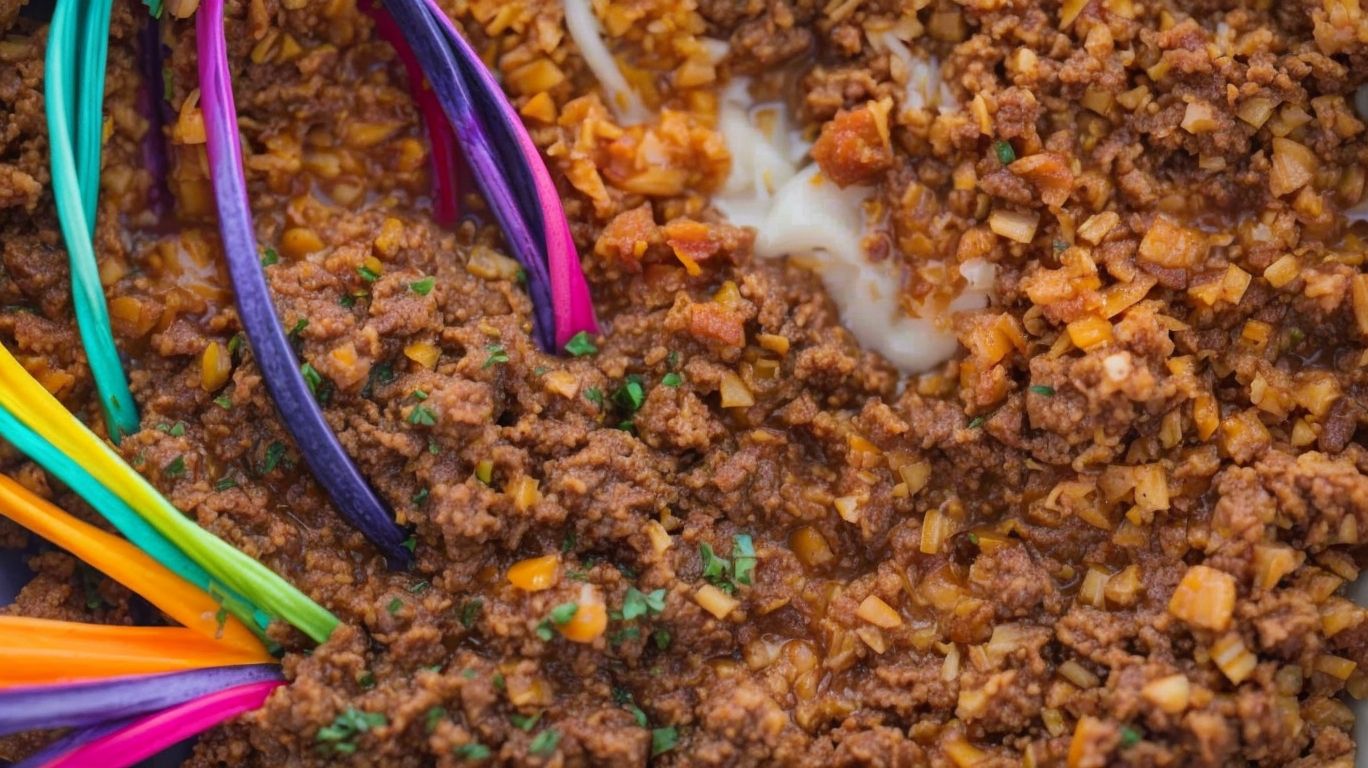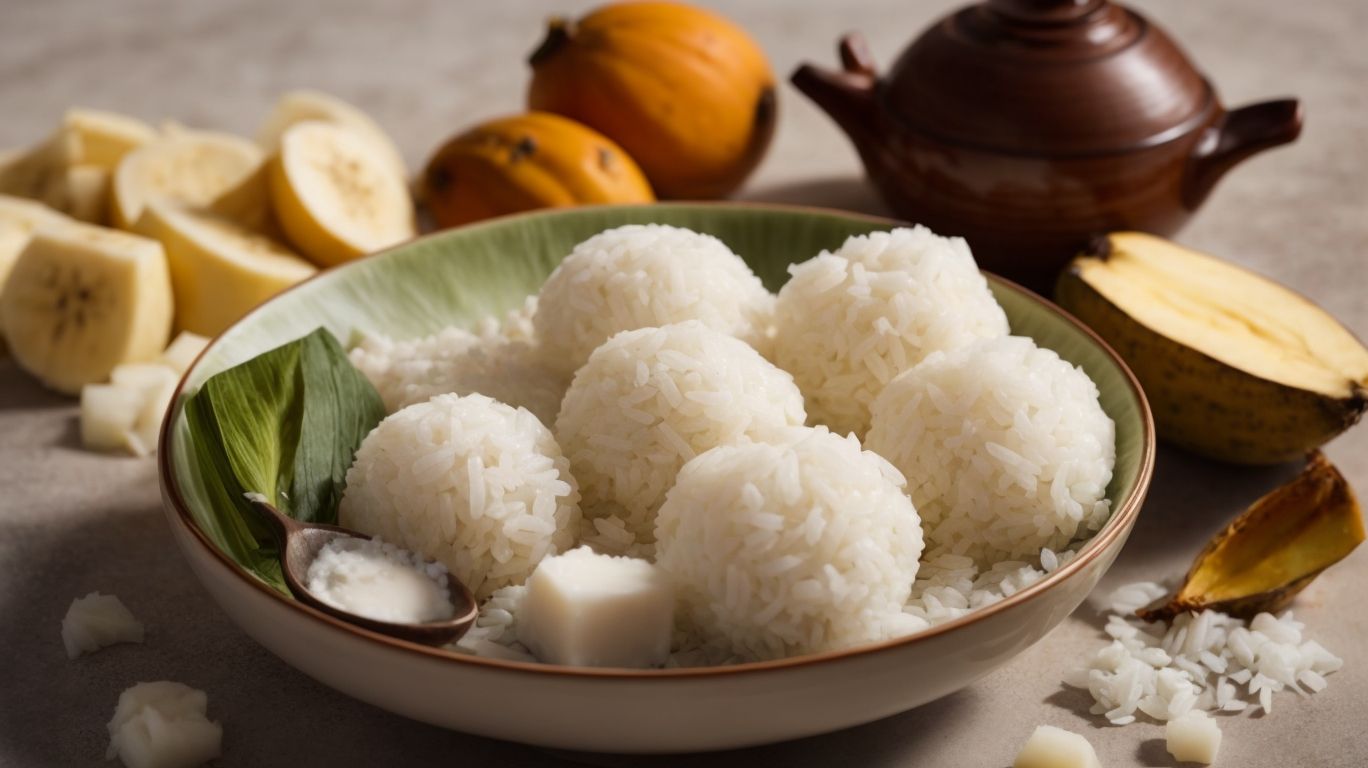How to Cook Bilo Bilo With Kamote?
Looking to add a delicious and nutritious Filipino dessert to your recipe collection?
Discover Bilo Bilo with Kamote! This article explores what Bilo Bilo and Kamote are, the ingredients needed, preparation methods, and step-by-step instructions on cooking this delectable dish.
Stay tuned for tips on achieving the perfect consistency for the Bilo Bilo balls and storing any leftovers. Let’s get cooking!
Key Takeaways:
What is Bilo Bilo?

Credits: Poormet.Com – Roy Brown
Bilo Bilo is a traditional Filipino dessert soup made with a delightful mix of coconut milk, sweet potato, jackfruit, glutinous rice, and tapioca pearls.
Originating from the Philippines, Bilo Bilo is cherished not just for its unique blend of flavors but also for its rich cultural significance in Filipino cuisine. The sweetness of the dessert comes from the harmonious combination of creamy coconut milk, starchy sweet potatoes, and the bursts of natural sweetness from jackfruit. Each ingredient plays a crucial role in creating this velvety and comforting soup. The glutinous rice and tapioca pearls add a chewy texture, making each spoonful a delightful experience that captures the essence of Filipino culinary tradition. Often served warm, Bilo Bilo brings a sense of warmth and nostalgia, making it a favorite for both special occasions and everyday indulgence.”
What are the Ingredients for Bilo Bilo?
The ingredients for Bilo Bilo include sweet potatoes, jackfruit strips, glutinous rice balls, tapioca pearls, and a rich coconut milk soup.
Each ingredient in Bilo Bilo plays a crucial role in creating the delectable flavor profile and unique texture of this Filipino dessert soup.
- Sweet potatoes: These add a natural sweetness and a soft, creamy texture to the soup, blending perfectly with the coconut milk base.
- Jackfruit strips: These bring a tropical fruity flavor and a chewy consistency, adding a refreshing touch to the overall dish.
- Glutinous rice balls: Also known as bilo bilo, these chewy, sticky rice balls provide a satisfying bite and absorb the flavors of the soup.
- Tapioca pearls: These small, translucent pearls offer a fun textural contrast, popping in your mouth with each bite.
- Rich coconut milk soup: The base of the dessert, this creamy and fragrant coconut milk soup ties all the ingredients together, giving the dish its signature richness and depth of flavor.
What is Kamote?
Kamote, also known as sweet potato, is a versatile and nutritious root vegetable commonly used in Filipino desserts.
Its vibrant orange flesh adds a rich sweetness to dishes, balancing the flavors in traditional Filipino desserts like Bilo Bilo. Besides its culinary uses, kamote packs a punch in terms of nutrition, being a great source of fiber, vitamins, and minerals. It’s a healthier alternative to regular potatoes, offering a lower glycemic index and higher levels of antioxidants. Whether boiled, mashed, or roasted, kamote brings a unique texture and taste that elevates any savory or sweet dish it’s added to.
What are the Nutritional Benefits of Kamote?
Kamote, or sweet potato, is a nutritional powerhouse packed with vitamins, minerals, and fibers, making it an excellent choice for both vegetarians and food enthusiasts.
One standout feature of kamote is its rich nutrient content, which includes high levels of Vitamin A, Vitamin C, and manganese, known for their antioxidant properties and immune-boosting benefits. Its high fiber content aids in digestion and promotes gut health. Kamote’s natural sweetness provides a healthy alternative to traditional sweeteners, making it a versatile ingredient in both savory and sweet dishes.
How to Prepare the Ingredients for Bilo Bilo with Kamote?
Preparing the ingredients for Bilo Bilo with Kamote involves sourcing fresh sweet potatoes, pandan leaves, and ripe tropical fruits to enhance the dessert’s flavors.
When selecting the sweet potatoes, opt for the ones that are firm, smooth-skinned, and free of any blemishes. These types of sweet potatoes will bring a natural sweetness and a pleasant texture to the dish.
For the pandan leaves, you can either find them fresh at select grocery stores or utilize pandan extract as a convenient alternative. The pandan leaves subtly infuse the dessert with a fragrant, floral note that complements the overall taste.
As for the ripe tropical fruits, consider using bananas, jackfruit, and sweet potatoes to add layers of contrasting flavors and textures. These fruits not only provide a burst of freshness but also contribute to the visual appeal of the dish.
How to Cut the Kamote?
Cutting the Kamote, or sweet potato, into uniform cubes or slices is essential for even cooking and consistent texture in various food recipes like the purple yam dessert.
One key factor to consider when cutting Kamote is the thickness of the slices, as it can impact the cooking time and texture of the dish. For the purple yam dessert, you want to aim for cubes or slices that are about half an inch thick to ensure they cook evenly and maintain a soft, yet slightly firm texture.
Another important tip is to make sure all the Kamote pieces are cut to a similar size to ensure they cook uniformly. This not only enhances the visual appeal of the dish but also ensures that each bite offers a consistent taste and texture experience.
How to Make the Bilo Bilo Balls?
Making the Bilo Bilo balls involves a simple process of combining glutinous rice flour, coconut milk, and water to create the sticky rice balls that form the heart of the dessert.
To start the process, a mixture of glutinous rice flour and water is kneaded to form a smooth, elastic dough. This step is crucial to achieve the desired sticky texture in the final product.
Once the dough is well-formed, it is divided into small portions and rolled into bite-sized balls, traditionally referred to as ‘Bilo Bilo’.
The next key step involves simmering these rice balls in a coconut milk broth, enhancing them with a rich, creamy flavor.
How to Cook Bilo Bilo with Kamote?

Credits: Poormet.Com – Gerald White
Cooking Bilo Bilo with Kamote involves simmering the sweet potato chunks, Bilo Bilo balls, and saba bananas in a luscious coconut milk sauce until all the flavors meld into a harmonious dessert.
The art of simmering in this recipe is crucial, as it allows the bold flavors of the sweet potatoes, chewy Bilo Bilo balls, and soft saba bananas to infuse with the rich coconut milk sauce, creating a luscious and comforting dessert. The slow simmering process ensures that all the ingredients absorb the creamy coconut goodness while retaining their individual textures and flavors. As the dish bubbles gently on the stove, the aroma of coconut fills the kitchen, signaling that the dessert is nearing completion.
Step 1: Boil the Kamote
Boiling the Kamote, or sweet potatoes, until tender is the first step in preparing a comforting and flavorful Filipino dessert, ensuring the root vegetable is soft and ready for further culinary creations.
When simmering the Kamote, it’s crucial to ensure a gentle boil rather than a vigorous one to prevent the sweet potatoes from breaking apart unappealingly. This slow and steady process allows the flavors to develop and infuse into the tubers, imparting that delectable sweetness that’s characteristic of Filipino delicacies. Consistency is key here, with the potatoes transforming into a lusciously soft texture that perfectly complements their natural sugars.
Step 2: Make the Coconut Milk Sauce
Creating the Coconut Milk Sauce involves simmering rich coconut milk with sweet stew ingredients like taro roots to achieve a creamy and indulgent base for dishes like Bilo Bilo.
This traditional method of preparing Coconut Milk Sauce captures the essence of tropical flavors with each simmering step. As the coconut milk blends with the taro roots, it imparts a velvety texture and subtle sweetness that elevate the dish to a whole new level of decadence. The gentle heat allows the flavors to mingle, creating a perfect harmony of creaminess and depth.
Dishes like Bilo Bilo benefit from this luscious sauce, as it adds a richness that complements the chewy rice balls and glutinous desserts. The final result is a culinary masterpiece that embodies the warmth and comfort of traditional Filipino cuisine.
Step 3: Add the Bilo Bilo Balls
Adding the Bilo Bilo balls and tapioca pearls to the coconut soup infuses the dish with a delightful chewy texture and enhances the coconut flavor profile of the dessert.
When these rice balls and chewy tapioca pearls are submerged into the creamy coconut soup, they absorb the rich flavors and add a burst of sweetness to every spoonful. The play of textures is truly satisfying as you encounter the soft, slightly sticky rice balls alongside the bouncy tapioca pearls.
The coconut soup takes on a comforting warmth and depth, complemented by the subtle sweetness from the Bilo Bilo balls and the pearls. The interplay of flavors creates a harmonious blend that appeals to both coconut enthusiasts and those new to this delightful dessert.
Step 4: Simmer and Serve
Simmering the Bilo Bilo with Kamote mixture until well combined and aromatic, then serve the purple sweet dessert soup as a delightful dessert or satisfying snack for any time of the day.
Once the flavors have melded beautifully in the pot, the aroma emanating from the simmering Bilo Bilo will envelop your senses, enticing you with its sweet and earthy fragrance. The consistency of the dessert soup should be thick and hearty, with the chewy texture of the glutinous rice balls contrasting perfectly with the softness of the purple sweet potatoes.
When it’s time to serve, ladle the steaming Bilo Bilo into bowls, ensuring that each portion is generously filled with the colorful ingredients. The versatility of this dish shines through as it can be enjoyed warm during colder months or chilled for a refreshing treat in the summer.
Tips and Tricks for the Perfect Bilo Bilo with Kamote
Achieving the perfect Bilo Bilo with Kamote requires attention to detail, from ensuring the rice balls are cooked through to serving the dessert soup at the ideal temperature for a delightful afternoon snack.
For the ideal rice ball consistency, aim for smooth and well-formed spheres that hold their shape but remain soft and chewy inside. Cooking them just until they float to the surface ensures they are cooked through without becoming too dense.
- In terms of the dessert soup, maintaining a warm but not boiling temperature is key. This allows the flavors to meld harmoniously without compromising the textures of the ingredients.
- Remember, presentation also plays a vital role in elevating the experience. Consider serving the Bilo Bilo with Kamote in a traditional wooden bowl or a colorful ceramic dish to enhance the visual appeal and make it even more tempting for enjoyment.
How to Achieve the Right Consistency for the Bilo Bilo Balls?
Achieving the right consistency for the Bilo Bilo balls involves a delicate balance of rice flour, tapioca pearls, and dessert cream to create a delicious dessert that holds its shape while offering a satisfying chew.
When preparing this delightful treat, the rice flour acts as the main binder, holding the tapioca pearls together in a cohesive mixture. The tapioca pearls add a delightful chewiness to the texture, creating a unique mouthfeel that enhances the overall experience. Combining these elements with the dessert cream not only adds sweetness but also helps in achieving the desired creamy texture that complements the chewy tapioca pearls. The interplay of flavors and textures in Bilo Bilo balls makes it a truly delightful dessert that satisfies both the sweet tooth and the craving for a comforting, satisfying treat.
How to Store Leftover Bilo Bilo with Kamote?
Storing leftover Bilo Bilo with Kamote involves transferring the dessert dishes to airtight containers and refrigerating them to preserve the flavors and textures, ensuring the ube flavor remains intact for later enjoyment.
By utilizing airtight containers, you create a barrier that prevents outside odors from seeping into the dessert, preserving its original taste. The refrigeration process not only helps in maintaining the freshness but also slows down the growth of any bacteria, ensuring the safety of consuming the leftovers. Refrigeration is crucial for retaining the delightful chewy texture of the glutinous rice balls and the softness of the sweet potato cubes.
Conclusion
In conclusion, Bilo Bilo with Kamote is a delectable dessert that blends the sweetness of coconut milk with the heartiness of sticky rice balls and the earthy flavors of sweet potato, offering a delightful culinary experience for all who indulge.
What sets this traditional Filipino delicacy apart is the combination of glutinous rice balls, sweet potato chunks, and bananas creating a symphony of flavors and textures. The sweetness from palm sugar balances the creamy coconut milk base, giving it a unique sweet-savory profile that lingers on the palate. Recipe notes recommend simmering the ingredients for the right amount of time to achieve that perfect chewy yet soft consistency in the sticky rice balls.
Frequently Asked Questions
1. How to Cook Bilo Bilo With Kamote?
To cook Bilo Bilo with Kamote, you will need glutinous rice flour, water, kamote, coconut milk, and sugar. Follow these steps:
1. In a bowl, mix glutinous rice flour with water until a smooth dough is formed.
2. Divide the dough into small balls and set aside.
3. In a pot, boil water and add the kamote. Let it cook for about 10 minutes.
4. Once cooked, remove the kamote from the pot and let it cool.
5. Mash the kamote and form it into small balls.
6. In the same pot, add coconut milk and bring it to a boil.
7. Add the rice balls and kamote balls into the pot and let it cook for 5-7 minutes.
8. Add sugar to taste and stir until well combined.
9. Serve hot and enjoy your delicious Bilo Bilo with Kamote!
2. What is the key ingredient in Bilo Bilo With Kamote?
The key ingredient in Bilo Bilo with Kamote is glutinous rice flour. It gives the dish its signature chewy texture and helps bind the ingredients together.
3. Can I use other types of flour to make Bilo Bilo With Kamote?
Yes, you can use other types of flour such as rice flour or all-purpose flour. However, the texture and taste of the dish may differ from the traditional Bilo Bilo with Kamote.
4. How do I know when the Bilo Bilo and Kamote are cooked?
The Bilo Bilo and Kamote are cooked when they float to the surface of the pot. You can also check by piercing the kamote with a fork, it should be soft and easily mashed.
5. Can I make Bilo Bilo With Kamote in advance?
Yes, you can make Bilo Bilo with Kamote in advance. Once cooked, let it cool completely and store it in an airtight container in the fridge for up to 2 days. When ready to serve, reheat it on the stovetop or in the microwave.
6. Can I substitute kamote with other root vegetables?
Yes, you can substitute kamote with other root vegetables such as sweet potatoes or yams. However, the taste and texture of the dish may vary slightly.






